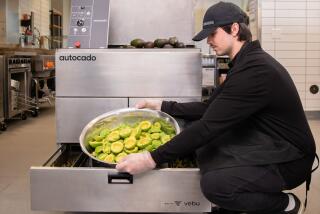Robots Take a Turn as Swiss Cheese Makers Battle Foreign Rivals : Industry: ‘They never complain and they have never run amok,’ one executive says about the money savers.
- Share via
ZOLLIKOFEN, Switzerland — In the chilly vaults where Swiss cheeses are laid out to ripen, the sounds of human labor are rapidly giving way to the clicks and whirs of robots.
Dubbed “cheese robots,” the bulky machines are taking over the crucial job of caring for the heavy wheels of Swiss cheese during the three to nine months needed for final aging.
Seven machines have come into operation in the past three years, five of them since early 1994, at the three biggest makers of the leading export cheeses, Emmental and Gruyere.
“They never complain and they have never run amok,” Rolf Nufer, Emmental’s director of the board, said of his four machines, which look like plastic-armored fork-lift trucks. “They’ve never dropped a wheel of cheese, and they are not built so they could hurl them at anybody.”
Each robot rolls slowly down aisles between ceiling-high shelves, trailing an electric cord for power and using hi-tech sensors to guide a claw-like pincer that lifts the cheese wheels, each weighing as much as 220 pounds.
The claw flips the cheese over to ensure even ripening, then slides it onto a revolving tray built into the robot’s long, narrow body.
A brush presses down and scrubs the cheese’s hard rind with saltwater, which removes mold and influences the final texture and flavor. Finally, the cheese is lifted out of the tray and returned to its place on the shelf.
The entire operation takes about one minute per cheese and each wheel needs to be turned and washed about every 10 days.
*
“It would take four men to do the same job as one robot,” Nufer said during a tour of his plant, where two sprawling store rooms for Emmental cheese and another two for Gruyere are tended by one robot each.
Engineer Werner Leu, whose three-person company in nearby Heimberg designed and oversaw construction of the robots, said he is not surprised at a complete lack of competition from bigger technology firms in Japan and Germany.
“The demand is just too limited,” he said. “Every cheese producer has different space requirements and different cheeses, so the robots have to be customized rather than coming off a mass assembly line.”
Cost-cutting is the main reason Swiss cheese companies are turning to automation.
Despite government subsidies, both exports and domestic sales have been hit by stiff competition from foreign cheeses not burdened by Switzerland’s high production costs or by the strength of the Swiss franc against other currencies.
One robot has a minimum working life of 10 years and costs about 315,000 Swiss francs ($264,000), roughly the same as a year’s wages and social benefits for four workers.
“You have to add in electricity for power and maintenance, but essentially the robot is paid for in two years,” Nufer said.
*
His two newest robots in the Emmental cheese rooms started work last November and December--the same time as the company expanded, so nobody was made redundant by the machines.
Other Swiss producers have automated in recent years by putting in conveyor belts for washing and tending their cheeses, but the robots are a new development.
All in all, Nufer said, the robots were popular with his workers as a labor-saving device, replacing shifts in cold vaults that have a sauna-like humidity of 75% to 95%.
At Nufer’s company and the other robot owners, Fromalp-Buergi and Refa, each machine has been given a traditional nickname in Swiss-German dialect.
Nufer’s two newest are dubbed Chrigu and Fridu, and they are hardy workers. When turnover at the warehouse is high, they can work 20 hours a day and at quiet times still put in at least 11 hours rather than a laborer’s eight- to nine-hour shift.
Each storeroom can hold about 3,000 wheels of Emmental. A digital counter on Fridu’s side showed it had washed and turned 108,372 wheels since starting operation last December.
A few times a day, a human worker stops by to move Fridu from the end of one aisle to the start of the next. The rest of the time, Fridu and its counterparts move slowly through the cheese stacks on their own, connected to the outside world only by an automatic signal that is sent to a foreman’s paging device if something breaks down.
“If they get lonely, they can always page someone,” Nufer said.
More to Read
Inside the business of entertainment
The Wide Shot brings you news, analysis and insights on everything from streaming wars to production — and what it all means for the future.
You may occasionally receive promotional content from the Los Angeles Times.










